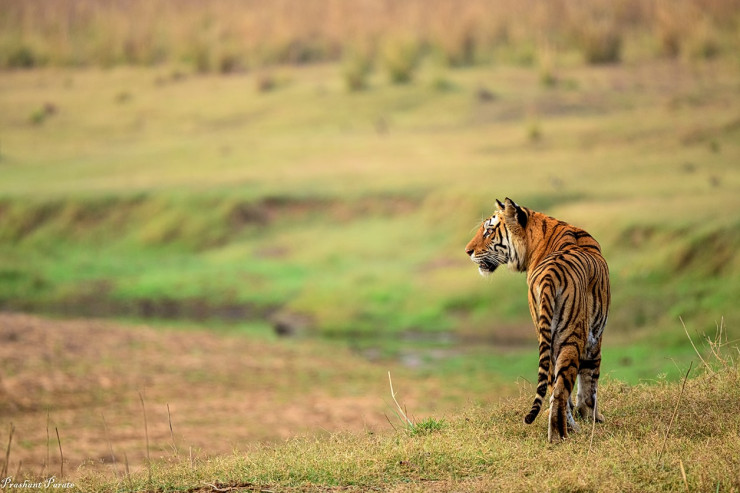
Existence of human population and honey combing type of settlements are the main destructive factors for the loss of biodiversity. In order to conserve biodiversity and the ecosystem as a whole, relocation of these settlements is the main challenge and priority. The relocation process was initiated in 2004-05 with the relocation of forest village Dhai, subsequently some the big forest villages like Bori, Sakot and Khakrapura were relocated in 2009-10, 2010-11 and 2011-12 respectively.
Relocation of Villagers:
The Satpura Tiger Reserve achieved land mark success in relocation and settlement of 38 villages from the core area, resulting in the creation of a contiguous habitat for wildlife. Relocation released about 8450.823 ha ideal habitat for wildlife. It also resulted in better living conditions for villagers: now they have access to facilities such as electricity, drinking water, schools, market place and health centers. More than 3243 families were relocated upto Dec 2016. This has resulted in the conservation of biodiversity, which include and endangered plants and animals.
Reclamation of Wildlife Habitat through Village Relocation:
Ever since the inception of Project Tiger in 1973, the philosophy of successful tiger conservation has emphasized on stringent protection, good prey base, and inviolate area with perfect tranquillity. Perfect tranquillity here means tigers areas need to be free from human habitations and anthropogenic activities. This is the most sensitive and challenging issue as human emotion is involved.
Voluntary Village Relocation in STR
The tiger continues to remain one of the most endangered large predators in the world. Based on scientific empirical data and simulation results for a viable tiger population, it has been established that a minimum inviolate area of 800-1200 sq.km. is required for a viable population of tiger (20 breeding tigresses). An ecologically sensitive zone (buffer, coexistence area, multiple use area) of 1000-3000 sq.km. is required around this inviolate space for sustenance of dispersal age tigers, surplus breeding age tigers and old displaced tigers. Together with the core area, this would sustain the dynamics of source-sink while sustaining a population of 75-100 tigers.
From the year 2004-05 to 2021-22 STR has relocated a total of 49 villages from the tiger reserve. Two options were chosen for the successful village relocation practices. Option-I (payment of the entire package amount of Rs. 15 lakhs per family) and option-II (Carrying out relocation/rehabilitation through the Forest Department).
Option A – Cash payment of Rs 15 lakhs to each relocated family
(i) Forest Village: 15 lakhs – 3 lakhs in the joint saving account of Husband and wife, and 12 lakhs in joint fixed deposit with Collector.
(ii) Revenue Village: Option A- 15 lakhs (inclusive of the assets value) to be deposited in the beneficiary / joint account of the married.
Option B- Compensation to the individual first as per asset value, and the remaining amount to be distributed equally.
Option C – Cash and Land – Rehabilitation through the forest department.
Impact of Village Relocation:
The STR has recorded the following beneficial outcome of village relocation from the protected area
• Over 10000 hectare area has been reclaimed for grassland management.
• Biotic pressure on forest has been reduced greatly. Human Population which have been moved from the PA to Outside is 12703 individuals while Cattle Population which has been moved from PA to Outside is of 12908 individuals.
• Before relocation, STR recorded 180-210 POR per year till 2016. However, after relocation, this number has been significantly reduced to 50-60 POR per year.
• Occupancy of wild ungulates has increased throughout the national park.
• Increase in wild ungulate populations has in turn also increased carnivore populations, especially tigers and leopards.
• The village relocation programme has also empowered the relocated villagers and secured their livelihood. Presently, the relocated have bought their own agricultural land, houses and other valuable assets like tractors. Their children also now also have the full opportunity for proper education. They also have the facility of clean drinking water, electricity and proper sanitation.
• Hassle-free and transparent village relocation has also strengthened bonds between the STR management and the relocated. Every year the STR management imparts community engagement trainings to the youths of relocated villages (trained as guides, housekeepers and cooks, vehicle drivers etc.) for job opportunities.
The successful relocation programme finds both the STR management and the relocated villages in a win-win situation. This hassle-free relocation programme in STR has been highly applauded by senior officers and public representatives.


